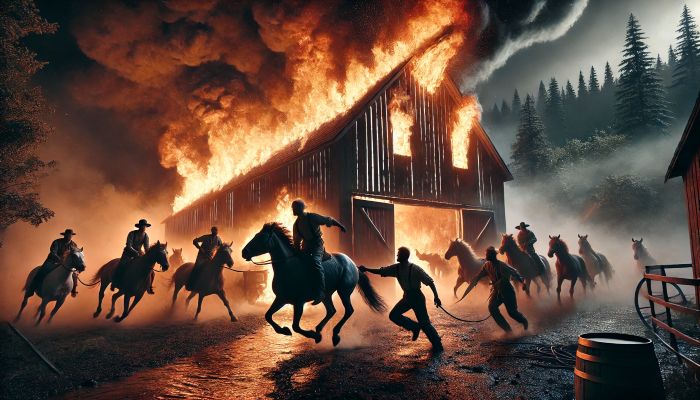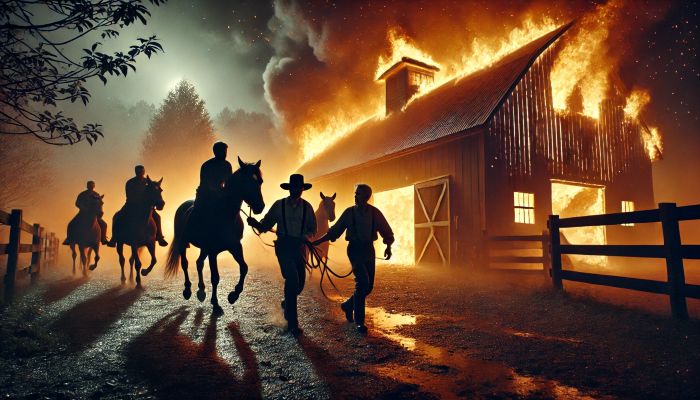Last Updated on February 11, 2025 by Teri Rehkopf
Horses are incredible animals, but when it comes to fire emergencies, they’re also surprisingly vulnerable. Their size, sensitivity to sudden changes, and dependence on people put them at serious risk. The worst part is that their instincts often backfire—panic takes over, making them hard to control and turning an already dangerous situation into a life-threatening one for both the horse and anyone trying to help.
Can Horses Sense Fires or Other Natural Calamities?
While horses do have keen senses, relying on physical signs and human action is crucial for safety. They might react to smoke or heat, but don’t assume they can sense a fire before it becomes dangerous.
I have never had to evacuate my horses in a fire situation, but as a teenager, I did ride my horse around our 30 acre property in the 20 foot wide dirt fire lanes to check on encroaching fires. I sometimes dismounted my horse to snuff out small fires endangering our place. Doing this, I developed a desire to become a forest ranger.
Common scenarios where horses are at risk usually involve a combination of fast-spreading fires and insufficient preparation. Wildfires can move incredibly quickly, giving little time to think, let alone act. Barn fires, whether caused by electrical faults or human negligence, also pose a significant threat, potentially overwhelming stables within minutes.

Related posts:
Horses in Disasters Series – Real-Life Survival Stories
Courageous Horse Stories of Survival in the California Wildfires
All Eyes on Hawke: An Equine Colorado Wildfire Survivor (2024)
Understanding these dangers is crucial. During any fire emergency, horses might react unpredictably due to the intense heat, smoke, and noise. They might try to return to what they perceive as safe ground or refuse to leave their stalls, highlighting just how critical a well-thought-out evacuation strategy is.
Observing the anatomy of a fire emergency helps us appreciate why having an evacuation plan is non-negotiable. Smoke inhalation alone can severely impact a horse’s respiratory health, and the stress of the situation can lead to long-term trauma.
So, recognizing these inherent risks is the first step to preparing for them effectively. Investing time in a detailed evacuation plan isn’t just sensible – it’s essential to safeguarding the well-being of these magnificent animals.
Developing a Comprehensive Evacuation Plan for Horses
In emergencies, having a solid evacuation plan for your horses is crucial. This section outlines the essential steps—from understanding your horses’ needs to assessing your property and available resources—to help you create a tailored strategy that ensures their safety when every second counts.
- Focus on Details and Your Environment:
- Developing an evacuation plan for horses requires careful attention to all the details and a solid understanding of the area where you live and keep your horses.
- Identify the Key Components:
- Know Your Horses’ Needs: Understand what your horses require in terms of safety, movement, and handling during emergencies.
- Recognize Constraints: Identify any physical limitations, such as narrow or limited exit routes, that could complicate an evacuation.
- Assess Available Resources: Determine what evacuation tools and resources (like trailers, emergency contacts, and transportation options) are accessible to you.
Conducting a risk assessment tailored to your stable’s specific situation is invaluable. Analyze the layout of your property and note all potential hazards and assets. For instance, access roads should be clear and large enough to accommodate emergency vehicles and horse trailers. Make arrangements for alternative transport if your primary transport fails.
Read this: The Horse that Jumped in a Swimming Pool During the 2018 Camp Fire, California
Building relationships with local emergency services is equally important. Knowing who to contact and having a list of reliable helpers can make a difference in a crisis. Partnering with neighbors to plan mutual aid in emergency scenarios also broadens your safety net.
A comprehensive evacuation plan should always be documented and preferably tested through drills. Regular training for you and your staff on these procedures ensures that everyone knows their role and can act quickly when it matters most.
Pre-Evacuation Preparation: What to Do Before Disaster Strikes
Having a solid plan in place is just the beginning; pre-evacuation preparation is where the groundwork for safety truly happens. A well-thought-out horse evacuation checklist is essential. Begin with basics:
- Make sure all horses are properly identified.
- Microchipping horses adds a layer of security and is highly recommended.
- Tags or collars with the horse’s name and contact information provide immediate identification.
Don’t underestimate the importance of reliable early warning systems. Keeping a weather alert radio handy and staying connected to local emergency channels can give valuable extra minutes to act. Mobile apps offering fire alerts tailored to your area can also be lifesavers.
With AM/FM/SW/NOAA Alert, Cell Phone Charger, Headphone Jack, Flashlight and SOS Siren
- AUTOMATIC NOAA WEATHER ALERT RADIO - This weather alert radio auto-scans for emergencies and weather alerts when you turn the device on or in standby mode. It alerts you if any emergency warning is issued.
- LARGE HD LCD DISPLAY - Includes digital auto-tuning so you can see the battery level and current tuning frequency
- 6-WAY CHARGING OPTIONS - A NOAA Weather Radio with multiple charging backup options. 6-way charging options include a built-in rechargeable backup battery, an AC adapter, DC 5V USB input,hand-crank, solar panel, and 3 AAA batteries (not included in packing).
- EMERGENCY RADIO & SOS ALARM - A built-in super-bright 3W flashlight and 2.5W reading lamp are critical in a power outage. It also includes a USB connector to charge your USB-enabled smart devices for communication. Simply press the SOS button to activate a loud alert and a flashing red light.
- PORTABLE RADIO & HEADPHONE JACK - This portable radio is small, light, and IPX3 water-resistant, only 1.2LB, and measures 6.8×3.7×2.9 inches, which is easier to carry anywhere. Includes a 3.5 mm headphone jack, allowing you to listen to the weather broadcast at night without disturbing your travel buddies.
Organizing paperwork is another step that shouldn’t be overlooked. Gather important documents such as identification papers, health records, and emergency contacts into a readily accessible package or digital format so they’re easy to grab in a hurry.
Read this: 8 Tips to Safely Evacuate Your Horse
Make sure to prepare the premises too. Clear pathways that could be used during evacuation and keep trailers in good condition for any unexpected rapid deployment. Ensure that necessary equipment is functional and prepared for immediate use.
I can relate on how much work it entails to prepare for an evacuation. I’ve been there, done that. Now that my horse passed away, I don’t have these worries about saving my horse. I do think about what we put into building a barn to withstand many emergencies and now it just stands there, unused.
Being methodical in these preparations secures the essentials and lessens the emotional stress on both you and your horses when it’s time to implement the evacuation plan.
The Evacuation Process: Executing a Safe and Efficient Plan
When the time comes to put your evacuation plan into action, clarity and calm are your best allies. First, ensure everyone involved knows exactly what their role is. Clear communication among handlers and any available help is critical for a smooth operation.
Read this: Looking for the Best Survival Prepper Supply Kits?
Begin with a step-by-step guide that you’ve practiced during drills.
- Leading horses calmly out of their stalls and onto trailers requires patience and familiarity.
- If panic sets in, having a trusted horse handler can make the process more manageable, as these professionals are skilled in keeping horses calm under pressure.
Learning from past large-scale evacuations offers valuable insights. Many communities have faced wildfires, and case studies from these events highlight the importance of having backup routes and transportation options.
Transporting horses safely depends on having reliable and accessible trailers and knowing the best routes to your designated safe places. Keep in mind that roads might be congested or blocked, so having a plan B is vital.
Read this: Beginner Guides: Needs Evaluation
Maintain a checklist to ensure nothing is left behind, from essential gear to feed supplies. Remember, implementing your plan efficiently can significantly reduce the stress placed on the animals, making a critical difference during an emergency evacuation.
Post-Evacuation Protocols: Ensuring Horses’ Well-being After the Fire
Emergencies don’t end once the danger has passed. Once your horses are safe, immediate care is crucial. Begin by checking each horse for injuries or signs of stress. A thorough examination helps address any health concerns before they become more serious.
Monitoring health is your next priority. Watch for signs of smoke inhalation or dehydration, which can occur even if they seem all right initially. Keeping detailed notes on each horse’s condition can assist veterinarians if further care is needed.
Managing stress is just as important as physical health. Horses, like people, may experience trauma after such events. Creating a calm and steady environment helps them adjust. Gradual reintroduction into normal routines aids in reducing anxiety and stress over time.
Handling reintegration into everyday patterns should be done thoughtfully. Pay attention to their behavior and allow them to readjust without pressure. This period can take time, but patience will lead to a smoother transition.
People Also Ask: Common Questions About Horse Evacuations During Fires
How do you keep horses calm during an evacuation?
Remaining calm yourself is key, as horses are sensitive to emotional cues from their handlers. Practicing regular loading drills can also help horses be more familiar with the process, reducing anxiety when the real event occurs.
What are a horse owner’s legal responsibilities during emergencies?
It’s essential to be aware of local laws and regulations. Owners are generally expected to ensure their animals’ welfare, including having a feasible evacuation strategy in place.
Are there community resources or networks that can be a lifeline in emergencies?
Indeed, local equine groups, emergency services, and social media pages often coordinate efforts and provide real-time information during crises. It’s wise to become familiar with these before you urgently need them.
Final Thoughts
Post-event community support can be incredibly beneficial. Engage with local networks or equine groups for advice and shared experiences. Often, these groups have insights derived from lived experiences that can provide comfort and practical solutions for moving forward.
What do you think? Have you had to evacuate your horse(s)? What were you evacuating from? What steps did you do in the evacuation? Were these steps planned or did you just wing-it? Let me know in the comments section below. I’d love to hear your perspective/issues/concerns and I always reply.


